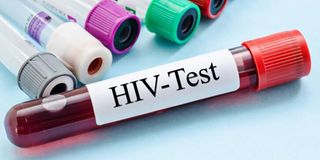Prime
HIV prevalence drops, says govt

The Ministry of Health has reported a general decline in the prevalence of HIV among the population as the fight against the scourge intensifies.
What you need to know:
- Dr Ruth Aceng said the HIV burden is shifting to older individuals aged 50-54 and 60-64. According to the report, in older people aged 50 to 54, the prevalence was two times higher than the national average at 13.6 percent.
- The 2020 Uganda Population-based HIV Impact Assessment (UPHIA) report, indicates that the prevalence of HIV among adults aged 15 to 49 years declined from 6 percent in 2016 to 5.5 percent as of 2020
The Ministry of Health has reported a general decline in the prevalence of HIV among the population as the fight against the scourge intensifies.
Released yesterday in Kampala by the Ministry, the 2020 Uganda Population-based HIV Impact Assessment (UPHIA) report, indicates that the prevalence of HIV among adults aged 15 to 49 years declined from 6 percent in 2016 to 5.5 percent as of 2020.
The report also indicates that there is a decline in prevalence of the disease among females, from 7.5 percent in 2016 to 7.1 percent in 2020, while in males it declined from 4.3 percent to 3.8 percent.
Although there was a general decline, a significant variation in prevalence of the virus was registered in the Ministry’s 11 geographical regions, with greater Masaka having the highest at 8.1 percent while Karamoja had the least at prevalence at 2.1 percent.
Five out of the 11 regions had prevalence above the overall national average. These include central 1 (greater Masaka), mid north (Lango), Kampala, south western region, and central 2 (Mubende, Luweero and Mukono).
Compared to figures of UPHIA 2016, Greater Masaka and mid north (Lango) also registered slight increases in HIV prevalence from 8.0 to 8.1 percent and from 7.2 to 7.6 percent, respectively, according to the UPHIA 2020 report.
Dr Jane Ruth Aceng, the Health minister, told journalists in Kampala that the survey was conducted between February 2020 and February 2021 with the aim of understanding the real burden of the disease for better planning.
“The survey collected information about the uptake of HIV prevention, care, and treatment services and offered home-based HIV counselling and testing, with referral to antiretroviral therapy (ART) clinics fpr those who tested HIV positive,” she said.
The survey was done countrywide among 10,685 households, 10,887 men and 15,169 women who were sampled randomly to represent the entire population. The national survey, which was funded by the American government, focused on those 15 years and older, according to the report.
Dr Aceng said overall, a total of 1.3 million Ugandans who are 15 years and above are living with HIV. She said the prevalence of HIV among people 15 years and above is at 5.8 percent.
“The prevalence of HIV in adults 15 years above was higher in urban areas (7.1 percent) than in rural areas (5.2 percent),“ she said, without explaining.
Dr Joshua Musinguzi, the head of AIDS control programme at the ministry, said the decline is a result of concerted efforts to curb the scourge.
“Overall, we are beginning to see a slight fall, or even a stabilisation because in the past, we were seeing rising HIV prevalence in the early 80s and 90s, and in 2000 it stagnated around 6.5 percent and in 2004 it shot up to 7.3 percent and now you can see 5.5 percent which signifies control of HIV [epidemic],” Dr Musinguzi said. “This [decline] is expected because as a country, we have succeeded in identifying a significant number of the HIV positive individuals and put them on treatment. And when you do that, you find that the population of people living with HIV will become healthier, and you will end up with reduced HIV deaths,” he added.
Dr Musinguzi said the decline also indicates that preventive measures such as abstinence, faithfulness to sexual partners and use of condom.
However, the number of HIV deaths was not indicated. Health officials said they are still finalising the writing of the report before releasing the complete version. On the variation in HIV prevalence among people in urban and rural areas, and across regions, Dr Musinguzi said it can be caused by differences in sexual behaviours and other factors.
He cited multiple sexual partners, non-use of condoms and lack of adherence to antiretroviral medication as contributors of increased infection.
“The variation of the prevalence can result from variation in sexual behaviours, culture of the places and uptake of HIV preventive services,” Dr Musinguzi said/
The UPHIA 2020 report, like the UPHIA 2016 report, indicates that HIV prevalence is higher among women.
In 2020, the prevalence is twice higher in women at 7.5 percent when compared to the number of infected men at 4.8 percent. This is for people aged 15 years and above.
Prof Pontiano Kaleebu, the director of Uganda Virus Research Institute, earlier said the HIV prevalence is higher in women because of greater risk of exposure to infected partners and genetic predisposition.
Higher burden among older people
Dr Ruth Aceng said the HIV burden is shifting to older individuals aged 50-54 and 60-64. According to the report, in older people aged 50 to 54, the prevalence was two times higher than the national average at 13.6 percent. This is higher than the 10.1 percent prevalence reported in UPHIA 2016 study. Dr Joshua Musinguzi said the high burden among older people means more young people are adopting preventive measures at higher rate than the elderly. Despite these variations, Dr Aceng said the new report indicates that the country is on track to end HIV as a public health threat by 2030.
READ:




